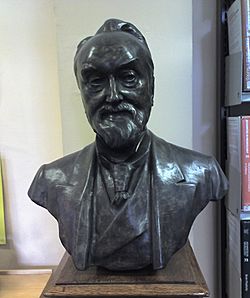John Hughlings Jackson facts for kids
Quick facts for kids
John Hughlings Jackson
|
|
|---|---|

Bust of John Hughlings Jackson, resident in the Institute of Neurology, London
|
|
| Born | 4 April 1835 Providence Green, Green Hammerton, Yorkshire, England
|
| Died | 7 October 1911 (aged 76) London, England
|
| Nationality | English |
| Scientific career | |
| Fields | Neurology |
John Hughlings Jackson (4 April 1835 – 7 October 1911) was an important English doctor who studied the brain and nerves, a field called neurology. He is best known for his research on epilepsy, a condition that causes seizures. He was also a Fellow of the Royal Society, a group of top scientists.
Contents
Life and Career
John Hughlings Jackson was born in Providence Green, a small village near Harrogate, Yorkshire. He was the youngest of four children. His father was a farmer and brewer. Sadly, his mother died when he was just over a year old.
He went to school in Tadcaster and Nailsworth. Later, he studied medicine at the York Medical and Surgical School. In 1856, he finished his training at St Bartholomew's Hospital in London. He then worked as a doctor at the York Dispensary.
In 1859, Jackson moved back to London. He worked at the Metropolitan Free Hospital and the London Hospital. By 1862, he became an Assistant Physician at the National Hospital for Paralysis and Epilepsy. This hospital is now known as the National Hospital for Neurology and Neurosurgery in Queen Square, London. He became a full Physician there in 1869.
He also worked as a Physician at the London Hospital starting in 1874. During these years, he became very well-known for his work in neurology. In 1878, he was chosen to be a Fellow of the Royal Society.
John Hughlings Jackson passed away in London on 7 October 1911. He was buried in Highgate Cemetery. A building at the University of York is named after him to honor his contributions.
Discoveries and Research
Jackson was a very creative thinker. He wrote many clear and detailed papers, even if he sometimes repeated himself. He is most remembered for his important work on understanding epilepsy. He studied all its different forms and how complex it could be.
His name is linked to a special way that seizures can spread. This is called the "Jacksonian March." It describes how symptoms of a seizure might start in one part of the body and then move to other parts. He also described the "dreamy state" that some people with temporal lobe epilepsy experience. This type of epilepsy affects a part of the brain called the temporal lobe.
Jackson also studied aphasia, which is when someone has trouble speaking or understanding language. He noticed that some children with aphasia could still sing, even if they couldn't speak normally. He also looked at how language was lost in patients with injuries to the left side of their brain. For example, some patients could still say common phrases like "Good bye" even if they couldn't form other sentences.
When he was younger, Jackson was very interested in big ideas about how the mind works. He even thought about leaving medicine to study philosophy. A key part of his work was about how the nervous system is organized. He suggested it has three levels:
- Lower level: This level controls simple movements. It includes parts like the spinal cord.
- Middle level: This level is in the brain's motor area, which controls more complex movements.
- Higher level: This level is in the front part of the brain (prefrontal area). It helps control and plan movements.
Jackson believed that the higher levels of the brain usually control the lower ones. If there was damage to a higher level, it could cause "negative symptoms" (a loss of function). But it could also cause "positive symptoms." These positive symptoms happened when the lower levels were no longer controlled by the higher ones. He called this process "dissolution."
Jackson was one of the few doctors to give special lectures at the Royal College of Physicians. These included the Goulstonian (1869), Croonian (1884), and Lumleian (1890) lectures. He also gave the Hunterian Oration in 1872.
How He Studied
John Hughlings Jackson did not have modern tools like MRI scans to study the brain. Instead, he relied on his sharp observation skills. He carefully watched his patients and used logical thinking. He also studied information from autopsies (examining bodies after death).
Some later neurologists have questioned some of his theories. However, Sir Francis Walshe, another famous neurologist, said in 1943 that even if some of Jackson's ideas are old, his work still contains "a rich treasure of physiological insight." This means his ideas about how the body works are still very valuable.
Otfrid Foerster, a researcher who studied the motor cortex (the part of the brain that controls movement), gave credit to Jackson for first suggesting that the brain is where neurological signals for movement begin.
Important Contributions
John Hughlings Jackson, along with his friends Sir David Ferrier and Sir James Crichton-Browne, helped start an important science journal called Brain. This journal focused on how experiments and clinical studies could work together in neurology. It is still published today, and its first issue came out in 1878.
In 1892, Jackson was one of the people who helped create the National Society for the Employment of Epileptics. This group is now called the National Society for Epilepsy. He founded it with other famous doctors like Sir William Gowers and Sir David Ferrier.
The famous neurologist Oliver Sacks often said that John Hughlings Jackson was a great inspiration for his own work in neurology.
Images for kids
See also
 In Spanish: John Hughlings Jackson para niños
In Spanish: John Hughlings Jackson para niños


